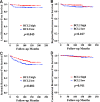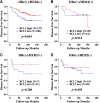Prognostic influences of BCL1 and BCL2 expression on disease-free survival in breast cancer
- PMID: 34099764
- PMCID: PMC8184896
- DOI: 10.1038/s41598-021-90506-x
Prognostic influences of BCL1 and BCL2 expression on disease-free survival in breast cancer
Abstract
We investigated the prognostic influences of BCL1 and BCL2 expression on disease-free survival in breast cancer patients. BCL1 and BCL2 expression statuses were assessed by immunohistochemistry using tissue microarrays from 393 breast cancer patients. The Kaplan-Meier estimator and log-rank test were used for survival analyses. The Cox proportional hazards model was used to calculate hazard ratio (HR) and the 95% confidence interval (CI) of survival analyses. BCL1 expression revealed no impact on survival. The high BCL2 group showed superior disease-free survival compared with the low BCL2 group (p = 0.002), especially regarding local recurrence-free survival (p = 0.045) and systemic recurrence-free survival (p = 0.002). BCL2 expression was a significant prognostic factor by univariable analysis (HR, 0.528; 95% CI, 0.353-0.790; p = 0.002) and by multivariable analysis (HR, 0.547; 95% CI, 0.362-0.826; p = 0.004). High BCL2 expression was associated with higher disease-free survival in the hormone receptor (HRc)-positive and human epidermal growth factor receptor 2 (HER2)-negative (HRc(+)/HER2(-)) subtype only (p = 0.002). The high BCL2 group was associated with positive estrogen receptor (ER), positive progesterone receptor (PR), low histologic grade, and age ≤ 50 years. BCL1 expression had no prognostic impact, but BCL2 expression was a significant independent prognostic factor. High BCL2 expression was associated with higher disease-free survival, especially regarding local recurrence and systemic recurrence. The prognostic effect of BCL2 expression was effective only in the HRc(+)/HER2(-) subtype. Favorable clinicopathologic features and a strong association with the ER/PR status could partly explain the superior prognosis of the high BCL2 group. BCL2 expression could be utilized to assess the prognosis of breast cancer patients in clinical settings.
Conflict of interest statement
The authors declare no competing interests.
Figures





Similar articles
-
A Ki67/BCL2 index based on immunohistochemistry is highly prognostic in ER-positive breast cancer.J Pathol. 2012 Jan;226(1):97-107. doi: 10.1002/path.2976. Epub 2011 Sep 26. J Pathol. 2012. PMID: 21953021
-
BCL2 in breast cancer: a favourable prognostic marker across molecular subtypes and independent of adjuvant therapy received.Br J Cancer. 2010 Aug 24;103(5):668-75. doi: 10.1038/sj.bjc.6605736. Epub 2010 Jul 27. Br J Cancer. 2010. PMID: 20664598 Free PMC article.
-
Differences in clinical importance of Bcl-2 in breast cancer according to hormone receptors status or adjuvant endocrine therapy.BMC Cancer. 2015 Oct 15;15:698. doi: 10.1186/s12885-015-1686-y. BMC Cancer. 2015. PMID: 26472348 Free PMC article.
-
Prognostic influence of BCL2 expression in breast cancer.Int J Cancer. 2012 Oct 1;131(7):E1109-19. doi: 10.1002/ijc.27539. Epub 2012 Apr 4. Int J Cancer. 2012. PMID: 22418857
-
Meta-analysis confirms BCL2 is an independent prognostic marker in breast cancer.BMC Cancer. 2008 May 29;8:153. doi: 10.1186/1471-2407-8-153. BMC Cancer. 2008. PMID: 18510726 Free PMC article. Review.
Cited by
-
TACkling Cancer by Targeting Selective Protein Degradation.Pharmaceutics. 2023 Oct 10;15(10):2442. doi: 10.3390/pharmaceutics15102442. Pharmaceutics. 2023. PMID: 37896202 Free PMC article. Review.
-
Evaluation of Immunohistochemical Marker Bcl-2 in Epithelial Dysplasia and Squamous Cell Carcinoma of the Oral Cavity.Cureus. 2024 Aug 10;16(8):e66576. doi: 10.7759/cureus.66576. eCollection 2024 Aug. Cureus. 2024. PMID: 39252711 Free PMC article.
-
Comprehensive pharmacokinetic profiling and molecular docking analysis of natural bioactive compounds targeting oncogenic biomarkers in breast cancer.Sci Rep. 2025 Feb 13;15(1):5426. doi: 10.1038/s41598-024-84401-4. Sci Rep. 2025. PMID: 39948091 Free PMC article.
-
Subtype-specific prognostic impact of Bcl-2 in HER2-positive and HER2-negative breast cancer.Sci Rep. 2025 Jan 6;15(1):920. doi: 10.1038/s41598-024-83302-w. Sci Rep. 2025. PMID: 39762296 Free PMC article.
-
Detecting the expression of HRs and BCL2 via IHC can help identify luminal A-like subtypes of triple-positive breast cancers.Clin Transl Oncol. 2023 Apr;25(4):1024-1032. doi: 10.1007/s12094-022-03007-2. Epub 2022 Nov 14. Clin Transl Oncol. 2023. PMID: 36376700
References
Publication types
MeSH terms
Substances
LinkOut - more resources
Full Text Sources
Medical
Research Materials
Miscellaneous

